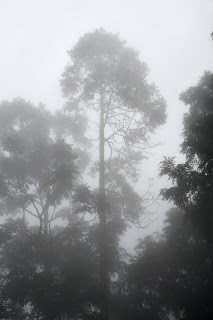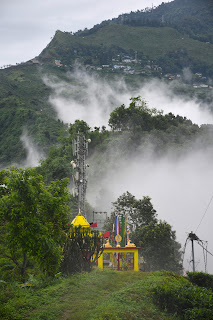India: Days 5-8 – On a tea estate in Darjeeling
I woke up a few minutes after four this morning as Sparsh began to rouse the house for our journey to the train station. Frantically but methodically, we washed ourselves and packed the last of our belongings before loading them into three cars and piling the fourteen-headed group inside them. The ride was smooth. Although I had been woken up a few times that night by the loudest thunder I had ever heard, the roads did not seem dangerously wet, and indeed, it was early enough in the morning that the lack of traffic added considerably to my feelings of safety.
We arrived at the
train station well before six, which was when our train for Siliguri departed. The
ride was beautiful. Through the window, I watched as the landscape passed us
by: the rice paddies, the evenly spaced groves, the palm trees shooting up from
the fields. I watched as graceful white egrets treaded through the greenery,
and as swallows perched themselves and bickered on electric wires. I saw people
wading through shallow lakes by the edges of rice paddies, tending to water
buffalo, and stooping for their crops. Every now and then, we would also ride
past menacing factory chimneys, which appeared like intruders from another planet.
At ten o’clock, the
train slowed down as we began to cross the broad course of the Ganges. By the
near bank, its waters were turbid, rushing in all directions with waves
overlapping like the wefts of competing weavers. This tumultuous strip was
bordered by heaps of green branches carried forth by the river, beyond which
began the smooth brown expanse of the mighty flow. With no ripples showing, it
seemed more like a lake than a river. Not even the pairs of pillars of another
half-constructed bridge were breaking any waves. Drawing towards the other
side, we saw dozens of cream-coloured boats moored by the bank, where brightly
dressed women gathered to wash their clothes.
Our train arrived near
Siliguri a little after one o’clock. The drivers working for the tea estate
were already waiting for us at the station, and I noticed that many of the
people here look much more like Nepalis and Bhutanis. The ride was enthralling.
Following the seven-hour train ride, we finally reached the mountains, and then
we started to thread our way up the winding roads. From the window, we observed
the luscious forests, the flowing mist, and the rows of tea bushes. At one
point, a monkey leapt onto the rails eating leftovers from a plastic wrapper,
and at another, we had to stop for the quaint little mountain train making its
way across the road.
The week we spent in
Darjeeling, at Sparsh's family's tea estate above Kurseong, was a quieter affair
than our stay in Kolkata. On Saturday, it only started to rain later in the
afternoon, giving us time for an outside breakfast and a BBQ. Once we ventured
out to walk around the estate, however, a true downpour began. Sophie embraced
the fact and let herself get completely soaked, while I clutched my camera
tightly under my arm to keep it from getting wet.
Once it had begun to
rain, the torrents seemed endless. They carried on through the following day,
when many of us fell ill with fevers, colds, and stomach issues. I caught a
cold myself, but I also felt sorry for the soaked monkey I saw strutting about the
soaked garden. At times, the rain would briefly stop and come back with a
vengeance. During one such window, we made another walk through the tea garden
and had the fortune to see the clouds clear, revealing mountains as far as
Nepal.
Still, most of the
time that it did not rain, it was misty. On Sunday’s walk, we observed mighty
bamboo grass rising out of the mist, sometimes at a distance against the
horizon, sometimes close up like reeds in a muddy pond. Standing by the tea
bushes, we could discern the wettened tea flowers and leaves attacked by
various pests, and our walk along the edge of the groves brought us close to a
massive kaffir lime tree which perfumed the whole area. Having let our guard
down, several people caught leeches on our walk.
The bad weather
cleared up somewhat on Monday, when the rain subsided and the mist set in
heavily. In the morning, we made an excursion through the hills and villages,
taking in new sights of tea-studded slopes and faraway houses. After lunch, we
also dropped by the old tea factory. Sparsh gave us a whole tour, beginning
with the drying process, and continuing to the sorting, roasting, and packing,
before finally having us try a few different types of tea. There are four times
during the year when tea leaves are plucked: first flush in the spring, second
flush before the monsoon, monsoon harvest, and autumn harvest. Each of these
periods is supposed to produce a different flavour, which is particularly true
of the monsoon, whose humidity requires the tea to be roasted at higher
temperatures.
(Sparsh’s mother has written
much more cogently about the different flushes on the estate’s blog: https://dorjeteas.com/blogs/posts/simplest-explanation-of-darjeeling-black-tea-and-its-four-flushes)







































Comments
Post a Comment